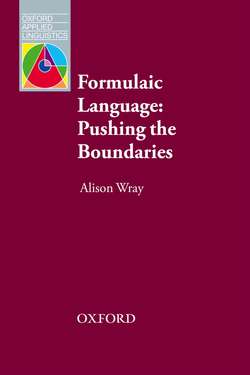Читать книгу Formulaic Language - Alison Wray - Страница 12
На сайте Литреса книга снята с продажи.
PART ONE
Determining boundaries
2
Conceptualizing formulaic language
The mental lexicon is heteromorphic
ОглавлениеThe theoretical position taken in this book, on the basis of evidence from multiple sources reviewed extensively in Wray (2002b), is that linguistic material is stored in bundles of different sizes (compare Jackendoff 2002: Chapter 6). That is, the mental lexicon contains not only morphemes and words but also many multiword strings, including some that are partly lexicalized frames with slots for variable material, treated as if they were single morphemes – they are MEUs (see definition above).
Not all strings of words, of course, are prefabricated. As linguistic theory has long recognized, what makes human language special is the huge potential it has for novel expression.3 This potential is only realized because we can both create and understand formulations that we have not encountered before – formulations that, therefore, cannot have been stored in memory in a fully lexicalized form.4
What goes into the lexicon
Because not everything can be stored in the lexicon, any model of how language is composed and understood needs to define criteria to determine which items will have their own entry. Separate consideration must be given to what characterizes a lexically stored word string (for example, regarding its meaning, function, form, and so on) and this matter is extensively discussed in Wray (2002b: Chapter 3). The focal issue here is the impact on the philosophy informing a theoretical model, when notice is taken of psychological processes and sociointeractional preferences as well as the basic patterns and the principles underlying them (see Chapter 6). For some theories it is important that one or another feature of the linguistic system be streamlined (i.e. pared of any unnecessary elements). The desirability of streamlining the system is partly a question of explanatory elegance, and partly, perhaps, a product of implicit or explicit assumptions about the constraints under which human language processing operates. For instance, perhaps there are restrictions on how much lexical information we can remember, though, in fact, there is no evidence of this. Other theorists prefer to keep the ‘rule system’ simple, even at the expense of a streamlined lexicon. That is the position adopted here.
Before the non-streamlined lexical model is explored, it will be helpful to review the main characteristics of the streamlined one. The more that lexical storage is streamlined, the more atomic the lexicon will become. That is, the way to minimize the size of the lexicon is to exclude any items that can be constructed by rule from smaller units. An atomic lexicon will be “like a prison, containing] only the lawless” (Di Sciullo and Williams 1987: 3) – there will be no items in the lexicon that are reducible to smaller semantic units in a somewhat regular way (see Wray 2002b: 265–74 for discussion). An atomic lexicon will still need to admit a few multiword strings, but only those that cannot be generated from smaller parts without a specific rule that has no wider applicability. Examples might include ‘by and large’, ‘very well’ (in the sense of ‘yes’), ‘to boot’ (in the sense of ‘also’), ‘no more’ (in the sense of ‘dead’), ‘at long last’ and ‘as well’, along with – at least for an English speaker with no knowledge of other languages – borrowed expressions such as ‘laissez faire’ and ‘je ne sais quoi’. On the other hand, many word strings could be excluded from an atomic lexicon, even though they carry hallmarks of formulaicity, for example, ‘perfect stranger’ and ‘pack it in’ (in the sense of ‘stop’). Although these items are non-literal in meaning they are regular in form, and so they can, according to such models, be generated using secondary meanings of the component words, or by employing second-order pragmatic mapping to give a holistic meaning to the composed form. Similarly, word strings with an unusual grammatical pattern, for example, ‘believe you me’, might be viewed as generated (using a specific rule) rather than holistically stored, because of the transparency of their meaning. Finally, frames containing a gap, for example, ‘what say we VERB?’ (meaning ‘why don’t we VERB?’), would be viewed as generated because they admit a potentially very wide range of completions.5
3
The opposition of ‘novel’ with ‘formulaic’ is customarily made in discussions about formulaic language, and it is a useful shorthand here. However, as the three claims described here unfold, it will become clear that the distinction is not sustainable, since it is no less novel to construct an utterance out of multiword lexical units than out of single words or morphemes. Of course, in the former the holistically-retrieved units may well provide runs of familiar configurations, but they are really no different from familiar words – just longer.
4
Some versions of Construction Grammar allow for everything to be lexically stored – see Chapter 7– since constructions can be partly or completely lexically unspecified. The point being made here is that the capacity for novelty must be accounted for somehow. In models that accommodate the existence of grammatical rules, albeit sometimes insertional ones that complete lexically stored frames, novelty is achieved by activating the rules to produce word strings that are not independently stored in the lexicon.
5
It is probably fair to say that the multiword strings most likely to be systematically excluded from an atomic lexicon are those containing a specified verb, for example, ‘take the trouble’; ‘make one’s way’; ‘haul over the coals’; ‘see to’. Almost all verbs inside formulaic sequences can be varied morphologically, and where the verb has a wider use than just within that sequence, there is a rationale (within that type of model) for not treating the word string as a lexical unit.
